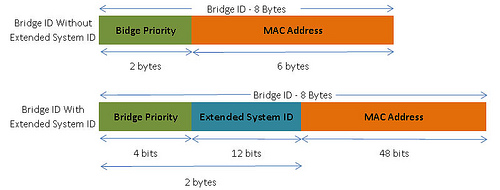- Cisco Community
- Technology and Support
- Networking
- Switching
- Re: STP - bridge priority - port priority - extended system ID
- Subscribe to RSS Feed
- Mark Topic as New
- Mark Topic as Read
- Float this Topic for Current User
- Bookmark
- Subscribe
- Mute
- Printer Friendly Page
- Mark as New
- Bookmark
- Subscribe
- Mute
- Subscribe to RSS Feed
- Permalink
- Report Inappropriate Content
07-12-2010 02:10 AM - edited 03-06-2019 11:59 AM
Dear friends,
I've been reading the MAC address reduction feature of the extended system ID command. I understood that enabling this command will change the priority bit allocation inside the bridge ID. Traditional 2 byte priority will be changed to 4 bits with the remaining 12 bit reserved for VLAN ID.
I would like to know if this command has any infulence on the priority field (port priority) of port ID??
As per my understanding, the port ID is 16bit with 6 bit for priority and 10 bit for port index, 128 being the default priority (range 0 to 240) as a multiple of 16. If priority really have 6 bits, then why it's a multiple of 16??
Hope someone can help me..
Thanks, Ameen Ahmed.
Solved! Go to Solution.
- Labels:
-
Other Switching
Accepted Solutions
- Mark as New
- Bookmark
- Subscribe
- Mute
- Subscribe to RSS Feed
- Permalink
- Report Inappropriate Content
07-13-2010 05:43 AM
Hi Ameen,
802.1t standards re-define the Port ID and Bridge ID field in STP BPDU's.
16 bith Port ID is divided into 4 bits of Port Priority and 12 bits of Port Number.
So with 4 bits for Port Priority, the value has to be multiples of 16 (just binary to decimal conversion).
Moreover this Port ID is not related to Bridge ID as there are separate fields in BPDU.
You can refer to the below URL's:
http://www.ietf.org/proceedings/51/slides/bridge-0/tsld016.htm
There is no field for VLAN while mentioning Port ID. You have to mention the VLAN's along with Port prioirty value when you want to modify it in the switches.
interface fa0/10
spanning-tree vlan 100 port-priority
Hope this answers your question.
thanks
Arun
Pls rate if this is helpful
- Mark as New
- Bookmark
- Subscribe
- Mute
- Subscribe to RSS Feed
- Permalink
- Report Inappropriate Content
07-12-2010 06:06 PM
Dear Ameen,
STP require each have a uniqe BID. With PVST required seperate instance of spaaning tree for each vlan.
But MAC address is uniqe so required to attach Vlan id. which will make BID uniqe for each Vlan.
That is possible in Extended sysid feature
e.d

Hope this will hwlp you.
Do not forget to rate this post if it will hel you.
Regards,
- Mark as New
- Bookmark
- Subscribe
- Mute
- Subscribe to RSS Feed
- Permalink
- Report Inappropriate Content
07-12-2010 10:44 PM
Dear Deepesh,
Thanks for your reply.. but actually I'm well aware of the fact that you've mentioned. Even I've mentioned it in my question. I know the effect of the Extended System ID command on the priority bits of bridge ID.
My question was, is there any affect on priority bit structure of port ID. Because, in some document I can see that the priority is 1 byte length with values between 0 to 255, default being 128 where as in some other document, it says priority is 6 bit long, with values between 0 to 240 as a multiple of 16.
This creates confusion. Also, just like the bridge id, is there any bits reserved for VLAN ID inside port ID? If vlan ID is not mentioned, how the priority change for particular vlan is handled?
Hope some one can answer my questions.
Thanks, Ameen Ahmed.
- Mark as New
- Bookmark
- Subscribe
- Mute
- Subscribe to RSS Feed
- Permalink
- Report Inappropriate Content
07-13-2010 05:43 AM
Hi Ameen,
802.1t standards re-define the Port ID and Bridge ID field in STP BPDU's.
16 bith Port ID is divided into 4 bits of Port Priority and 12 bits of Port Number.
So with 4 bits for Port Priority, the value has to be multiples of 16 (just binary to decimal conversion).
Moreover this Port ID is not related to Bridge ID as there are separate fields in BPDU.
You can refer to the below URL's:
http://www.ietf.org/proceedings/51/slides/bridge-0/tsld016.htm
There is no field for VLAN while mentioning Port ID. You have to mention the VLAN's along with Port prioirty value when you want to modify it in the switches.
interface fa0/10
spanning-tree vlan 100 port-priority
Hope this answers your question.
thanks
Arun
Pls rate if this is helpful
- Mark as New
- Bookmark
- Subscribe
- Mute
- Subscribe to RSS Feed
- Permalink
- Report Inappropriate Content
07-13-2010 06:46 AM
Dear Arun,
Thanks to your post. Your post was helpful indeed. And those links was really informative.. It cleared all of my doubts in this topic.
Once again thanks a lot...
Regard, Ameen Ahmed.
Discover and save your favorite ideas. Come back to expert answers, step-by-step guides, recent topics, and more.
New here? Get started with these tips. How to use Community New member guide